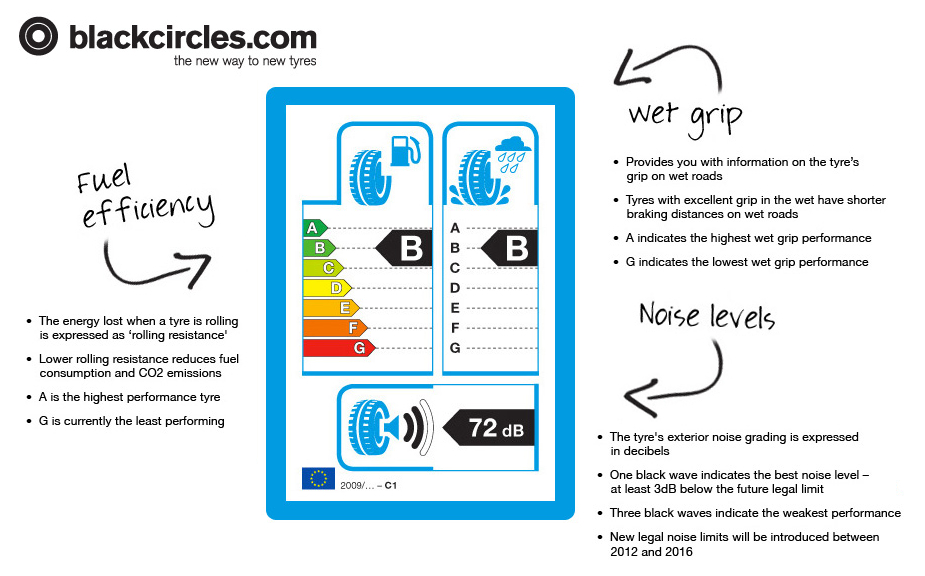Low Cost Shipping New Zealand Wide
Contact 0800 624 347
Open 6 days a week, Mon - Sat
0 Items in cart
An article about the EU Tyre labelling requirements and what it means to you.

Below you will find the new EU Tyre Label. Set to follow in the same style as the current energy efficiency labels, you will notice the familiar A -G grading system.
As of November 2012, every tyre in the EU will come with a label just like this, making the comparison between different makes and models easier than ever.


 The energy lost when a tyre is moving is described as 'rolling resistance' and has a direct impact fuel consumption and the environment. The tyres on a car can affect its fuel economy by 20%. The lower the rolling resistance, the tyre less energy is lost - reducing fuel consumption and CO2 emissions.
The energy lost when a tyre is moving is described as 'rolling resistance' and has a direct impact fuel consumption and the environment. The tyres on a car can affect its fuel economy by 20%. The lower the rolling resistance, the tyre less energy is lost - reducing fuel consumption and CO2 emissions.
In the EU Tyre Regulation label, rolling resistance is expressed in grades, ranging from A to G. A is the highest performance tyre in its category; G is currently the least performing. D is not going to be used as a grade, helping to draw a clear line between the top and bottom three grades - the good and the bad.
Putting the scores into perspective, if fitting the worst scoring tyres in this category, you could end up using 6 litres more fuel every 625 miles than if you fitted 'A' rated tyres - so, potentially, 'A' rated tyres could save you enough in fuel bills to buy a new set of tyres!


 A tyre's exterior noise grading is expressed in decibels, accompanied by one, two or three sound waves. One black wave indicates the best noise level performance. It means that the noise level of the tyre is at least 3dB below the future legal limit.
A tyre's exterior noise grading is expressed in decibels, accompanied by one, two or three sound waves. One black wave indicates the best noise level performance. It means that the noise level of the tyre is at least 3dB below the future legal limit.
Three black waves indicate the weakest performance in terms of tyre noise output. It represents a noise output level between the current maximum and the new lower limit that will be introduced in Regulation 661, between 2012 and 2016.

View original Article here http://www.blackcircles.com/general/tyre-labelling/tyre-label

 The wet grip label provides you with information on an important safety aspect of a tyre: its grip on wet roads. Tyres with excellent grip in the wet have shorter braking distances on wet roads, an important safety benefit when driving in rainy weather. The ratings are measured via two types of test when a car is travelling at 50mph.
The wet grip label provides you with information on an important safety aspect of a tyre: its grip on wet roads. Tyres with excellent grip in the wet have shorter braking distances on wet roads, an important safety benefit when driving in rainy weather. The ratings are measured via two types of test when a car is travelling at 50mph.
In the EU Tyre Regulation label, a tyre's wet grip capacity is also expressed in grades from A to G, with A the highest wet grip performance. Like the fuel efficiency score, D is not going to be used as a grade. On top of this, there are no plans at the moment from the EU to use G either.
The difference in braking distances between each grade is roughly 3m - the average length of 1 car. Making the difference between A and G 18m, 4 car lengths! This distance could be the difference between being involved in a road accident or not.


Although the information presented in the tyre label helps motorists understand how well a tyre performs in certain important areas, there are many other factors for you to consider when purchasing a tyre.
Other important factors that should be considered are, resistance to aquaplaning, driving stability, handling performance on wet & dry roads, durability of the tyre, braking performance on dry roads and the capabilities of the tyre in winter weather.